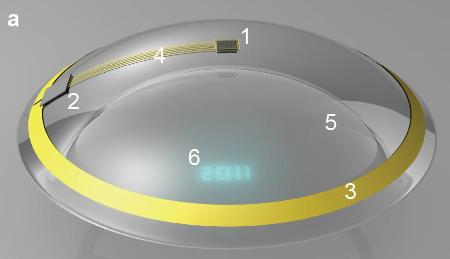Researchers belonging to the Aalto University in Finland and the University of Washington have created a prototype contact lens that can provide hands-free information updates to the wearer. Terminator-style information-vision is making progress towards reality.
The researchers have constructed the computerized contact lens and have also demonstrated its safety. The lens comprises an antenna that is capable of harvesting power that is being sent out by an external source. It also has an integrated circuit that is designed to store the energy and can then transfer the power to a transparent sapphire chip that contains a single blue LED.
 A single-pixel wireless contact lens display
A single-pixel wireless contact lens display
The researchers tested the device on the live eyes of a rabbit, and no adverse side effects were observed. The device at present consists of a single pixel. But this can be considered as a "proof-of-concept" for making multiple pixel lenses, which could display text messages and short emails before the wearer’s eyes.
The human eye cannot resolve objects that are on contact lenses, as their focal distance is several centimeters. So, information that is projected on the lens will not be clear. To address this issue, the researchers included a set of Fresnel lenses in the device. These Fresnel lenses are flatter and thinner than traditional bulky lenses. The researchers used these lenses to focus the image on to retina.
The device can be linked to biosensors in a person’s body for acquiring lactate or glucose levels. It can also be used in navigation systems, and gaming devices by overlaying visual information generated by computers on to the real world. Many improvements have to be done to the device so that it can produce high-resolution, remotely powered and completely functional displays.
Professor Babak Praviz, a co-author of the study, stated that improvements in antenna design, and optimization of the transmission frequency could help improve the wireless power transmission range. He added that the next goal of the research was to include a specific text in the lens.
The study was published in the Journal of Micromechanics and Microengineering from IOP.